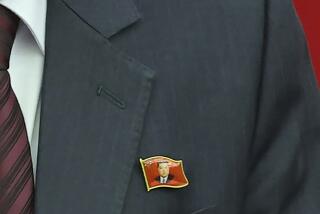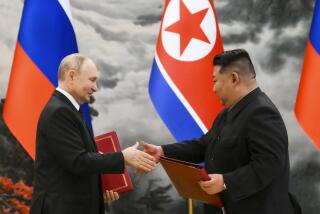North Korea’s progress seems to be more style than substance
DANDONG, China — Every time Kim Kyung Ok takes the bus into North Korea’s downtown Pyongyang, she’s startled by changes that look positively futuristic in a country that had been stuck in a 1960s time warp.
Women wearing fancy shoes, miniskirts and trousers, fashions popularized by the chic wife of North Korea’s not-yet 30-year-old leader. Brand new high-rise apartment buildings, which she’s heard have washing machines and refrigerators. People walking down the street yammering into cellphones stuck to their ears.
All things that, for now, at least, seem beyond the reach of the 52-year-old Kim, who, although she counts herself among the privileged as a resident of the North Korean capital, can barely afford to eat rice.
“Of course, they’re showing off with their cellphones. Who wouldn’t?” she snapped.
The death of leader Kim Jong Il in December and the ascent of his son Kim Jong Un, not to mention a decades-overdue modernization of Pyongyang, have leavened the unremitting gloom that has hung over North Korea since famine killed off nearly 10% of the population in the 1990s.
But North Koreans interviewed recently across the border in China say the changes so far are superficial and have done little to ease the daily task of just staying alive.
“There is more construction, more people building things, more to buy in Pyongyang. But day to day, our life is actually harder,” said Kim, who like many North Koreans working outside the country uses a pseudonym.
The price of rice (so important that the word for rice is synonymous with food) has nearly doubled since the beginning of the year, the result of declining foreign aid, a weak harvest and hoarding by speculators.
“Maybe 1 out of 10,000 North Koreans can afford to eat white rice every day like the people in China,” said a 58-year-old man from Suncheon, 30 miles north of Pyongyang, who has been working in a brick factory in China.
At North Korea’s state-owned factories, wages are so low (often less than $1 per month) that people will pay for the privilege of not showing up to work. They use their time instead to collect firewood or edible greens or to trade something on the market.
As for the vaunted North Korean military, rank-and-file soldiers have so little to eat that their parents have to send money and food for them to survive. Cornfields have to be guarded 24 hours a day to prevent thievery, with many of the culprits being hungry soldiers.
But for ordinary North Koreans, a few small changes have made life easier.
Just one month after Kim Jong Il’s death, authorities lifted socialist-style restrictions on the markets that limited the sale of staples and forbade men and younger women from market activity, the rationale being that they ought to be in their factories. In April, regulations on vendors in Pyongyang were eased, allowing for a proliferation of small kiosks selling beverages and snacks.
North Koreans expected an announcement of economic reforms at a special session of the Supreme People’s Assembly late last month, perhaps allowing farmers to keep more of their produce. Although nothing was forthcoming, they are still hopeful that the new leader will bring about change.
“People expect reform from him because he is so young,” said Park Jeong Suk, a 50-year-old woman from Chongjin, in the far northeast, who said she has been in China since August. “They talk all the time about North Korea needing to open up.”
Kim Jong Un has already purged some senior military officials, elevating the ruling Workers’ Party above the military in the power hierarchy and moving away from his father’s doctrine of “military first.” An aid official with extensive experience in North Korea said that during a recent visit to Pyongyang, a senior official told a visiting delegation, “The party and the people together are much stronger than nuclear weapons” and “in order to grow our economy, we need a peaceful atmosphere.”
The new leader also appears to be working closely with his uncle, Jang Song Taek, a longtime advocate of liberalization who has traveled widely, even to South Korea.
Pyongyang’s face-lift was put in place under the leadership of Kim Jong Il, who timed the new construction for completion in 2012 to mark the centennial of the birth of his father, Kim Il Sung. University students were press-ganged into doing much of the construction work.
The Ryugyong Hotel, a 105-story pyramid that has loomed empty and unfinished over the city for two decades — a national joke — is under construction again. The project is funded by Orascom, an Egyptian telecommunications firm that began cellphone service in North Korea a few years ago.
“Now people can use cellphones to do business and check on prices,” said the man from Suncheon.
In contrast to the Stalinist concrete blocks, Pyongyang’s new apartment buildings have modernist curved facades and are illuminated at night in geometric patterns. There is a new airport terminal, a “Dolphinarium” at the amusement park and an upscale Singapore-funded restaurant and department store. In front of the Pyongyang train station, a large digital screen displays North Korean television.
“It all looks new and shiny and beautiful in a country that is so poor,” said Jerrold Green, president of the Los Angeles-based Pacific Council on International Policy, who led a delegation to Pyongyang six weeks ago. He warned, however, against excessive optimism, comparing the transition in North Korea to Syria in 2000, when Bashar Assad succeeded his father.
“We heard almost exactly the same. ‘He speaks English, he went to school abroad, his wife dresses beautifully, so this must mean change,’” Green said. “And you can see what happened.”
And there are plenty of signs that life hasn’t changed much for the vast majority of North Koreans.
Outside of the relative privilege of Pyongyang, the North Koreans said, it is still common for people to die of starvation, albeit not at the same rate as during the famine of the 1990s.
Park said that from January through May of this year she’d seen three elderly women out on the streets who appeared to be dead.
“Young people have a hard time surviving themselves, so sometimes they have to kick the old people out of the house,” Park said.
The North Koreans all described widespread dissatisfaction with the late Kim Jong Il, whom they saw as opposed to economic reform.
“Many people didn’t like him so much because their lives were so hard under his rule,” said Park, speaking in a low, urgent voice.
“When Kim Il Sung died, we felt like the world had ended and we couldn’t go on living. We cried desperately,” said Kim Kyung Ok, the woman from Pyongyang, referring to the dynasty’s founder, who died in 1994. “I cried too for Kim Jong Il, but to be honest, not so much.”
Kim counts herself among North Korea’s privileged by virtue of her residency in Pyongyang, although she, like others, barely eats rice and has to supplement her diet with wild greens. She is a surprisingly elegant woman with delicate skin like creased linen and thick, curly black hair that she ties back at the nape of her neck in a classically demure North Korean style. She is 5 foot 3, relatively tall for a woman of her generation, and taller than either of her adult sons, who she says were stunted by a hungry childhood.
Her older son, 25, was recently discharged from the military because of malnutrition and is recuperating at home. “A meal was usually just three potatoes,” she said.
Kim begins her day at 5 a.m., when she hikes out into the mountains to look for edible greens to feed her pigs. The tastier pickings she marinates or stir-fries for her family.
During the day, she produces alcohol out of corn and acorns, using the dregs from the process to feed the pigs.
“You have to have two or three businesses going on to survive,” she said. Her younger son, 20, paid $3 per month not to go to his factory job so he is able to help her during the day.
Their workday extends well after midnight, as somebody in the family needs to keep watch over the pigs. Bands of hungry soldiers often come between 1 a.m. and 3 a.m.
For all that effort, Kim’s family never gets to eat pork, which is too valuable. They trade it instead for rice and corn, occasionally killing a rabbit if they need to add meat to their diet.
Like many North Koreans, Kim says she is still trying to recover from the government’s decision in 2009 to introduce a new currency, invalidating the old and wiping out the life savings of much of the population.
“People had heart attacks from the shock. Many people died,” Kim said, adding that she lost 5 million Korean won, then worth nearly $1,500.
“I was saving money for my older son to get married. I thought I could buy him an apartment,” Kim said.
Now her ambitions are more modest: She wants to buy her sons a camera and a cellphone.
More to Read
Sign up for Essential California
The most important California stories and recommendations in your inbox every morning.
You may occasionally receive promotional content from the Los Angeles Times.










